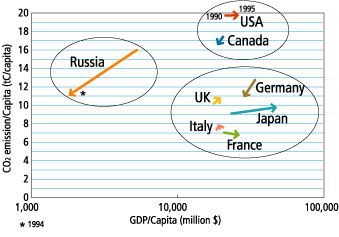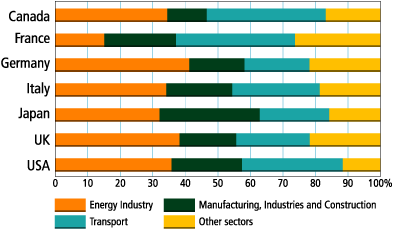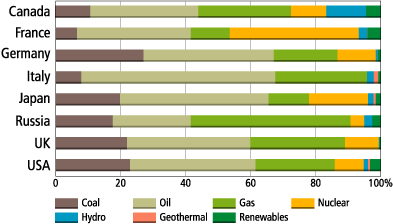
![]()
|
Institute for Global Environment Strategies / Keio University G8 Environmental Futures Forum 2000 |
|
| 1. Introduction 2. Objectives 3. G8 Countries and Climate Change 4. Questionnaire Survey of Best Practices in G8 Countries 5. Key Findings and Key Questions |
1. IntroductionDuring the last decade as humanity realized the threat of climate change, research, negotiations, and attempts to mitigate climate change have accelerated. New initiatives in various sectors of society in many countries include regulatory, economic and voluntary measures, as well as awareness-raising, education and others. Governments striving to find effective ways to limit climate change have been discussing the concept of "best practices", referring to the optimal or most progressive initiatives among countries' domestic measures to mitigate climate change. The Buenos Aires Action Plan adopted at COP4 of the UN Framework Convention on Climate Change referred to "best practices" in a "Request to the secretariat to prepare a report on "best practices" in policies and measures for consideration by SBSTA 11" (Decision 8/CO.4), as a task to prepare for the first COP/MOP. At the meeting of G8 Environment Ministers held in Schwerin, Germany in 1999, it was agreed that the next Environmental Futures Forum would exchange experiences about domestic Best Practices addressing climate change, and that a report of the results would be made for consideration by the G8 Environment Ministers' Meeting in 2000. The Forum serves as a platform for policy makers, scientists, scientific advisors to governments, and representatives from important stakeholders in society such as the private sector, non-governmental organizations and local communities of G8 countries. Through the Forum, countries to exchange information, ideas and opinions concerning environmental problems, and promote synergies in finding solutions to those problems. The Environment Agency of Japan undertook the survey of the Best Practices of domestic efforts of G8 countries to address climate change during the autumn of 1999. A questionnaire was sent to the concerned agencies in each country; the results have been compiled and are reported here for discussion. After the Environmental Futures Forum in February 2000, the outcomes will be reported at the G8 Environment Ministers' meeting to be held in April 2000 in Shiga Prefecture, Japan. It is expected that the analysis and reporting of main elements and special features of Best Practices can be helpful not only to G8 countries but also to many other countries and regions, in promoting the desirable measures needed to mitigate climate change. This report is a summary of the findings of the survey, to be used as a basis for discussion during the Environmental Futures Forum and for further exchanges of views. |
2. ObjectivesThe objectives of the report are
|
3. G8 Countries and Climate ChangeQuantitative data and indicators on G8 countries, such as greenhouse gas (GHG) emissions, GDP, and energy consumption, were analyzed in order clarify the relationship between G8 countries and climate change. The main results of the analysis can be summarized as follows: 3-1 GHG emissions in G8 countries |

|
Figure 1 Share of CO2 emissions from fossil fuel burning and cement manufacturing in 1995 |

|
Figure 2 CO2 emissions per capita in G8 countries and world average (1995) |
| 3-2 GHG emissions and GDP G8 countries account for approximately 70% of the global GDP. (Figure 3) Analysis of the relationship between GDP per capita and CO2 emissions per capita shows that G8 countries can be divided into three groups: the U.S. and Canada with high CO2 emissions per capita; Germany, the UK, Japan, Italy and France with comparably low CO2 emissions per capita and high GDP per capita; and the Russian Federation with low values for both. (Figure 4) (Note: The start point of each arrow indicates the value in 1990; the end point indicates the value in 1995.) |

|
Figure 3 Share of GDP in 1995 |

|
National Accounts Database of the Statistics Division of the UN Secretariat Figure 4 Relationship between GDP per capita and CO2 emissions per capita |
| 3-3 CO2 Emissions from Each Sector The energy industry accounts for 30 to 40% of CO2 emissions from each country except France. (Figure 5) Japan has the largest ratio of CO2 emissions from manufacturing, industry and construction, despite its efforts to promote energy saving in these sectors. Canada, France, and the U.S. have a comparably high ratio in the transport sector. (Appropriate data to compare the Russian Federation with other G8 countries not available.) |

|
Figure 5 Ratio of CO2 emissions from each sector (1995) |
| 3-4 Composition of Energy Supply The composition of energy supply in G8 countries vary, reflecting different natural and social characteristics in each country. (Figure 6) The energy supplied from coal was comparably high in Germany, the U.S, and the UK. Italy tends to depend on oil, whereas the dependency on nuclear power is comparably high in France. Hydroelectric, geothermal, and renewable energy comprise a very small proportion of the energy supply in every country. |

|
Figure 6 Composition of energy supply (1995) |
| 3-5 Results of Analysis The above analysis leads to three important conclusions: (1) Because the total GHG emissions from G8 countries accounts for about 50% of total global emissions, those countries should implement effective domestic measures to reduce their own emissions; (2) High GDP levels of G8 countries imply that they are influential actors, and their policies and measures can have repercussions for the world; (3) Similarities and differences among G8 countries, such as energy supply and economic conditions, imply that some common policies and measures can be implemented, while others need to be developed that are suitable for the different characteristics of each country. |
4. Questionnaire Survey of Best Practices in G8 Countries4-1 Rationale and Methodology In collecting information on Best Practices, the Environment Agency of Japan (EAJ) requested G8 countries to select 10 to 20 Best Practices among their measures taken to mitigate climate change in their own countries and summarize them according to a set format. They were also asked to attach relevant materials on each Best Practice, such as data or other supporting materials. Requests for cooperation and survey forms were sent out on 9 September 1999. The survey was implemented through Institute for Global Environmental Strategies. All G8 countries selected their Best Practices and sent them to the Environment Agency between late October and early January. Countries were asked to describe three key aspects of each Best Practice: special characteristics of the practice; reasons for inclusion as a Best Practice; and problems faced during implementation and how they were overcome or resolved. The gist of each Best Practice has been compiled into short summaries. For more detail please refer to the long versions. |
| 4-2 Definition of Best Practices The following definition of Best Practices was proposed for the survey so that all countries could share a common awareness selecting and discussing them: |
|
practices that represent the optimal or most progressive initiatives among the domestic measures being undertaken by a country or other social actors within the country to prevent global climate change.
|
| The description for the survey also stated that the term may include policies, plans and other initiatives which have indirect impacts, effects over a wide region, or effects over the medium or long term. The social actors who implement Best Practices include national and local governments, businesses, NGOs and individuals. Just as the practices of each separate actor are important, so are practices promoted through cooperation between actors.
In addition, the following basic guidelines were suggested in order to aid selection. |
| Best Practices: | |
| - | have actually been effective in reducing GHG, and provide excellent examples of past efforts, |
| - | are challenging and emerging approaches, |
| - | can contributes to the formation of future policies to prevent global warming, |
| - | are useful for consideration by social actors other than G8 countries implementing domestic initiatives in developed countries, |
| - | can be evaluated quantitatively and/or qualitatively, |
| - | can be appropriate for application in, or technical transfer to, developing countries, and |
| - | utilize local know-how and experience. In addition, they must be suitable to the natural environment and society of the country or area where they are implemented. |
| 4-3 Results of Questionnaire Survey
4-3-1 Summary of Best Practices in G8 countries |
| G8 country | Best Practices reported |
| Canada | 9 |
| France | 7 |
| Germany | 5 |
| Italy | 7 |
| Japan | 17 |
| Russian Federation | 2 |
| UK | 13 |
| USA | 19 |
| EU | 2 |
| Total | 81 |
| 4-3-2 Classification of the Best Practices The questionnaire requested information about Best Practices in five main categories: energy and industry, household and commercial, transportation, agriculture, land use and forestry, and cross-sectoral. The results of the classification were compiled based on those categories. (Tables 2 to 6) It should be noted that the practices could be classified in a number of ways. For example, the practices could be categorized by stakeholder (e.g. citizen, private company, non-governmental organizations, and government). Another useful way may be to classify the practices according to type of measure (e.g. regulations, economic incentives, voluntary actions, and education). In this survey, the above-mentioned sector-based classification was selected in order to encourage discussions in the working groups. |
| G8 countries |
Energy and industry |
Household and commercial |
Trans- portation |
Agriculture, land use and forestry |
Cross- sectoral |
Total |
| Canada | 4 | 1 | 4 | 9 | ||
| France | 2 | 3 | 1 | 1 | 7 | |
| Germany | 2 | 2 | 1 | 5 | ||
| Italy | 3 | 3 | 1 | 7 | ||
| Japan | 3 | 4 | 3 | 2 | 5 | 17 |
| Russian Federation |
2 | 2 | ||||
| UK | 5 | 3 | 2 | 1 | 2 | 13 |
| USA | 9 | 4 | 1 | 5 | 19 | |
| EU | 1 | 1 | 2 | |||
| Total | 28 | 16 | 10 | 5 | 22 | 81 |
| Note: "Best Practices reported" refers here to either individual practices/policies or "packages" of multiple practices, depending on the reporting style of countries in their submissions to the EAJ survey. In addition, it must be noted that countries submitted Best Practices based on their ability to contribute to useful discussions at EFF 2000, and thus neither include nor represent all initiatives being undertaken. |
| Energy and industry Best Practices Energy and industry Best Practices refer to practices in the energy supply sector such as electric power and gas companies, as well as practices in industry sectors (i.e. manufacturing). Twenty-six practices were in the energy and industry category, generally thought to be the most important sector to implement policies and measures to mitigate climate change because of their large contributions to GHG emissions. The United States selected 9 practices in this sector. |
| Total | 28 | |
| (1) | Restructuring/privatization of electric companies | 2 |
| (2) | Promotion of renewable energy and unutilized/underutilized energy | 5 |
| (3) | Industries' voluntary agreements and voluntary plans for emission reductions | 12 |
| (4) | Development of innovative technologies for reducing GHG emissions | 5 |
| (5) | Establishment of information infrastructure regarding energy use technologies and energy-related policies | 4 |
| Household and commercial Best Practices Best Practices in the household and commercial sectors include measures related to activities in daily life and purchasing and those related to houses and buildings. Commercial sector here refers to the non-manufacturing sector. Sixteen practices were categorized in this group, and practices improving the energy efficiency of houses and buildings were selected by most G8 countries. |
| Total | 16 | |
| (1) | Measures related to daily life | 3 |
| (2) | Measures by NGOs | 2 |
| (3) | Promoting introduction of energy saving goods in purchasing | 2 |
| (4) | Improving the energy efficiency of houses and buildings | 9 |
| Transportation Best Practices Transportation Best Practices include both policies and measures to change existing transportation infrastructure and land-use patterns and those related to demand management of transportation. Ten practices were classified in this category. Italy selected 3 such practices, half of the total number for that country. |
| Total | 10 | |
| (1) | Reform of fuel taxes | 2 |
| (2) | Shift to alternative vehicle fuels and energy sources for transportation | 1 |
| (3) | Changing behavior and promoting voluntary restraint of transportation by automobiles | |
| (4) | Development of innovative technologies for vehicles | 1 |
| (5) | Regulation and encouragement to smooth automobile transportation (Transportation Demand Management) | 3 |
| (6) | Application of new technologies to automobile transportation systems | 1 |
| (7) | Enhancement of means of transportation other than automobiles | 2 |
| Agriculture, land use and forestry Best Practices Only 5 practices were selected in the agriculture, land use and forestry category, reflecting the characteristics of industrialized G8 countries. |
| Total | 5 | |
| (1) | Reduction of GHG emissions from agricultural systems | 3 |
| (2) | CO2 sequestration by forest conservation and afforestation | 1 |
| (3) | Carbon substitution | 1 |
| Cross-sectoral Best Practices Cross-sectoral Best Practices relate to issues affecting multiple sectors. Many practices can be placed in this category. Practices collected from G8 countries were sub-categorized into several groups, including integrated policy design and legislation, taxation systems, funding mechanisms, central/regional government assistance and regional/local government initiatives, measures corresponding to the Kyoto mechanisms, and other indirect measures. Twenty-two practices were included in this category. |
| Total | 22 | |
| (1) | Integrated policy design and legislation | 3 |
| (2) | Establishment of taxation systems | 3 |
| (3) | Creation of funding mechanisms for climate change prevention | 4 |
| (4) | Central/regional government assistance; regional/local government initiatives | 6 |
| (5) | Measures corresponding to the Kyoto Mechanisms | 3 |
| (6) | Promotion of indirect measures for preventing climate change | 3 |
| 4-3-3 Comments by the United States and European Union In their responses to the questionnaire, the U.S. and EU added comments about Best Practices that may be useful for other countries.
In the United States, our experience with Best Practices indicates that they are most successful when they are: The EU added the following comment.
The concept of the "best practice" can refer to several things, including |
5. Key Findings and Key QuestionsBased on the above mentioned results of the survey, key findings and key questions were extracted as follows: 5-1 Key findings
In addition to the above mentioned major findings, the following findings in each sector were extracted. Energy and industrial sector
Household and commercial sector
Transportation sector
Agriculture, land use and forestry sector
Crosscutting sector
5-2 Key Questions
|
|
Report on the Best Practices submitted in response to the survey
by the Environment Agency of Japan |
|||||
|
|
|||||